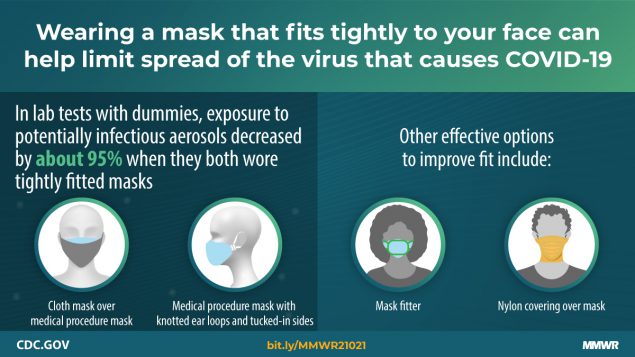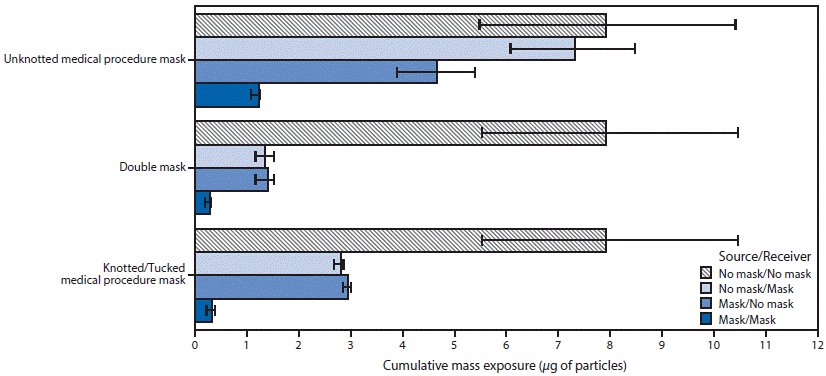Two masks are better than one
Until good vaccination coverage is achieved, face masks remain highly effective for slowing the spread of SARS-CoV-2, and a good mask fit is crucial to ensure its protective role.
Can we improve the effectiveness of face masks?
Laboratory simulations conducted by the CDC highlight the importance of a good mask fit to optimise mask performance. Until good vaccination coverage is achieved in the population, face masks remain a highly effective means of slowing the spread of SARS-CoV-2 when combined with other protective measures.
Made in cooperation with our partners at esanum.it
The US Center for Disease Control and Prevention (CDC) has released new recommendations on face mask use. Face mask use still remains an important weapon against the novel coronavirus, especially in light of new emerging variants, such as the rapidly expanding B.1.1.7, which is thought to be 40-70% more infectious than the variants that were prevalent in 2020.
The masks substantially reduce droplets and aerosols exhaled by the wearer and reduce exposure to these particles. Cloth and surgical masks are less tightly fitting than other types, such as FFP2/N95. The effectiveness of cloth masks and surgical masks can be improved by ensuring that they fit snugly around the face to prevent air leakage from the edges.
During the past month, CDC has conducted experiments to evaluate the effectiveness of surgical mask use by ensuring a proper fit for reducing exposure to droplets and aerosols. The experiments assessed what happens in cases when mask users:
- Wear a fabric mask over a surgical mask (double mask).
- Wear a surgical mask, knotting the elastic bands and then tucking and flattening the excess material at the edges of the face (knotted and tucked mask).
During the experiments, test dummies connected to particle emission devices were used. The results of a first experiment showed that the surgical mask alone with the unknotted ear elastics blocked 56.1% (standard deviation [SD]= 5.8) of the emitted particles, the tissue mask alone blocked 51.4% (SD= 7.1). The combination of the two masks (double mask) blocked 85.4% of the particles (SD= 2.4), while the knotted and tucked surgical masks alone blocked 77.0% (SD= 3.1).
In a second experiment, the double mask or the knotted and tucked surgical mask used on the particle source reduced the cumulative exposure of the receiver without a mask by 82.2% (SD= 0.16) and 62.9% (SD= 0.08), respectively. When the source was deprived of the mask and the receiver was fitted with a double mask or a knotted and tucked surgical mask, the cumulative exposure of the receiver was reduced by 83.0% (SD = 0.15) and 64.5% (SD = 0.03), respectively. When the source and receiver were both fitted with double masks or knotted and tucked surgical masks, the cumulative receiver exposure was reduced by 96.4% (SD = 0.02) and 95.9% (SD = 0.02), respectively.
These laboratory experiments highlight the importance of a good mask fit to maximise overall performance. The results of this report are subject to several limitations. First, the experiments were conducted with one type of surgical mask and one type of cloth mask from the many choices that are commercially available. Furthermore, measurements of their performance were made in a controlled environment. These results may not be generalizable to children because of their smaller size or to men with beards and moustaches, which interfere with fit.
Controlling SARS-CoV-2 transmission is critical not only to reduce the widespread effects of the COVID-19 pandemic on human health and the economy, but also to slow viral evolution and the emergence of variants that could alter transmission dynamics or affect the utility of diagnostics, therapy, and vaccines.
Source:
Brooks JT, Beezhold DH, Noti JD, et al. Maximizing Fit for Cloth and Medical Procedure Masks to Improve Performance and Reduce SARS-CoV-2 Transmission and Exposure, 2021. MMWR Morb Mortal Wkly Rep. ePub: 10 February 2021. DOI: http://dx.doi.org/10.15585/mmwr.mm7007e1

